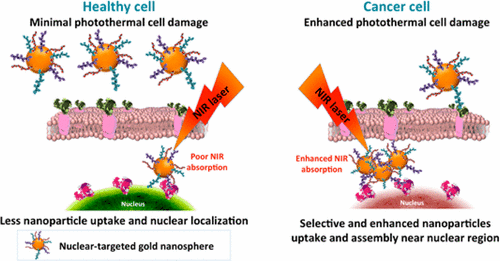当前位置:
X-MOL 学术
›
Bioconjugate Chem.
›
论文详情
Our official English website, www.x-mol.net, welcomes your feedback! (Note: you will need to create a separate account there.)
Intracellular Assembly of Nuclear-Targeted Gold Nanosphere Enables Selective Plasmonic Photothermal Therapy of Cancer by Shifting Their Absorption Wavelength toward Near-Infrared Region
Bioconjugate Chemistry ( IF 4.7 ) Pub Date : 2017-09-07 00:00:00 , DOI: 10.1021/acs.bioconjchem.7b00427 Sajanlal R. Panikkanvalappil 1 , Nasrin Hooshmand 1 , Mostafa A. El-Sayed 1
Bioconjugate Chemistry ( IF 4.7 ) Pub Date : 2017-09-07 00:00:00 , DOI: 10.1021/acs.bioconjchem.7b00427 Sajanlal R. Panikkanvalappil 1 , Nasrin Hooshmand 1 , Mostafa A. El-Sayed 1
Affiliation

|
Despite the important applications of near-infrared (NIR) absorbing nanomaterials in plasmonic photothermal therapy (PPT), their high yield synthesis and nonspecific heating during the active- and passive-targeted cancer therapeutic strategies remain challenging. In the present work, we systematically demonstrate that in situ aggregation of typical non-NIR absorbing plasmonic nanoparticles at the nuclear region of the cells could translate them into an effective NIR photoabsorber in plasmonic photothermal therapy of cancer due to a significant shift of the plasmonic absorption band to the NIR region. We evaluated the potential of nuclear-targeted AuNSs as photoabsorber at various stages of endocytosis by virtue of their inherent in situ assembling capabilities at the nuclear region of the cells, which has been considered as one of the most thermolabile structures within the cells, to selectively destruct cancer cells with minimal damage to healthy cells. Various plasmonic nanoparticles such as rods and cubes have been exploited to elucidate the role of plasmonic field coupling in assembled nanoparticles and their subsequent killing efficiency. The NIR absorbing capabilities of aggregated AuNSs have been further demonstrated both experimentally and theoretically using discrete dipolar approximation (DDA) techniques, which was in concordance with the observed results in plasmonic photothermal therapeutic studies. While the current work was able to demonstrate the utility of non-NIR absorbing plasmonic nanoparticles as a potential alternative for plasmonic photothermal therapy by inducing localized plasmonic heating at the nuclear region of the cells, these findings could potentially open up new possibilities in developing more efficient nanoparticles for efficient cancer treatment modalities.
中文翻译:

核靶向金纳米球的细胞内大会通过将其吸收波长移向近红外区域,使癌症的选择性等离子光热疗法成为可能。
尽管近红外(NIR)吸收纳米材料在等离子光热疗法(PPT)中具有重要的应用,但是在主动和被动靶向的癌症治疗策略中,它们的高产率合成和非特异性加热仍然具有挑战性。在目前的工作中,我们系统地证明典型的非近红外吸收等离子体纳米颗粒在细胞核区域的原位聚集可以将其转化为有效的近红外光吸收剂,这是由于等离子体吸收发生了明显的变化,从而在癌症的等离子体光热疗法中成为有效的近红外吸收剂。波段到NIR区域。由于它们在细胞核区域的固有原位组装能力,我们评估了以核靶向的AuNSs在胞吞作用各个阶段作为光吸收剂的潜力,它被认为是细胞内最不耐热的结构之一,可以选择性地破坏癌细胞,而对健康细胞的损害却最小。已经开发了各种等离子粒子,例如棒和立方体,以阐明等离子场耦合在组装的纳米粒子中的作用及其随后的杀灭效率。已使用离散偶极近似(DDA)技术在实验和理论上进一步证明了聚集的AuNS的NIR吸收能力,这与等离激元光热治疗研究中观察到的结果一致。
更新日期:2017-09-07
中文翻译:

核靶向金纳米球的细胞内大会通过将其吸收波长移向近红外区域,使癌症的选择性等离子光热疗法成为可能。
尽管近红外(NIR)吸收纳米材料在等离子光热疗法(PPT)中具有重要的应用,但是在主动和被动靶向的癌症治疗策略中,它们的高产率合成和非特异性加热仍然具有挑战性。在目前的工作中,我们系统地证明典型的非近红外吸收等离子体纳米颗粒在细胞核区域的原位聚集可以将其转化为有效的近红外光吸收剂,这是由于等离子体吸收发生了明显的变化,从而在癌症的等离子体光热疗法中成为有效的近红外吸收剂。波段到NIR区域。由于它们在细胞核区域的固有原位组装能力,我们评估了以核靶向的AuNSs在胞吞作用各个阶段作为光吸收剂的潜力,它被认为是细胞内最不耐热的结构之一,可以选择性地破坏癌细胞,而对健康细胞的损害却最小。已经开发了各种等离子粒子,例如棒和立方体,以阐明等离子场耦合在组装的纳米粒子中的作用及其随后的杀灭效率。已使用离散偶极近似(DDA)技术在实验和理论上进一步证明了聚集的AuNS的NIR吸收能力,这与等离激元光热治疗研究中观察到的结果一致。



























 京公网安备 11010802027423号
京公网安备 11010802027423号